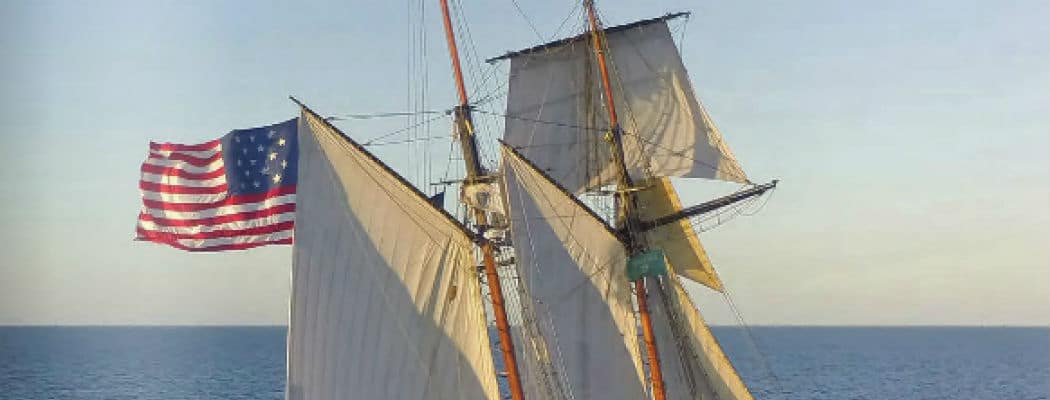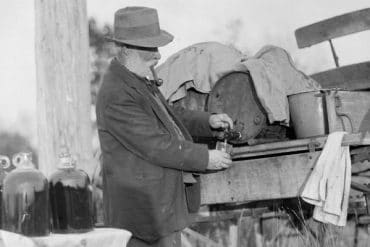On the 200th anniversary of the Battle of Nantucket, a replica Baltimore Clipper of the privateer Lynx gives a fitting salute.
Ask someone on the street to name a major battle in the War of 1812 and you will most likely just get a blank stare in response. There’s no Gettysburg or D-Day that sticks out in our national consciousness when it comes to this so-called “Second War of Independence” fought between the United States and England over free trade and sailors’ rights. For Nantucketers, this disconnect with our history is especially striking, as one of the greatest battles of the War of 1812 just so happened to be fought directly off our shores. In fact, one of the island’s own sons was on board during this naval engagement in which a crew of thirty-six Americans valiantly fought off five barges of 150 British soldiers. Historians say the Battle of Nantucket exemplified the determination of our fledgling nation and helped turn the tides of the war.
Keeping this history alive in a dramatic way is the privateer Lynx, which sailed around Nantucket’s waters throughout this summer and fall. On October 11th at 8 p.m., the Lynx commemorated the 200th anniversary of the Battle of Nantucket by firing a cannon blast for every minute of the bloody engagement. The Lynx was built in Rockport, Maine, in 2001 using plans drawn up by the British when they captured the original Lynx on Rappahannock River back in 1813. As a result, the 122-foot privateer clipper schooner sails through the water as it did two hundred years ago, but instead of running British blockades, this Lynx is teaching students about the War of 1812 and American exceptionalism through traditional sailing on the high seas.
Climbing aboard, one is met with a colorful crew dressed in historic garb. Captain Erik Lohse mans the helm in a regal, gold-buttoned peacoat, while his crew scurries around the deck, readying to set sail. Everything aboard the vessel is authentic, including the orders the first mate calls out to his crew. They hoist the sails, pulling in passengers to share the load. “Two! Six! Two! Six!”
 Helping bridge the gap between the 1800s and the modern day is Donald Peacock, the president of the Lynx Educational Foundation. Peacock is a lifelong Nantucket summer resident and is largely to thank for the Lynx’s presence around the island. In collaboration with the Egan Maritime Institute’s Sea of Opportunities, the Great Harbor Yacht Club, and private on-island supporters, Peacock and the Sea of Opportunities brought the Lynx to Nantucket to take a group of island scholars on the ride of their lives this August. Four students sailed from Nantucket to Mystic Seaport, where they tied up along the historic whaleship, the Charles W. Morgan. On their return voyage, they caught a mako shark that they ate right on the deck. Since then Peacock and his crew have taken hundreds of Nantucketers onboard the Lynx. “I have been enriched all of my life by Nantucket,” Peacock says. “This is my gift back to the place I love the most in the world… [I’m] so fortunate to be in a position of running a tall ship that I can give back through a significant maritime experience.”
Helping bridge the gap between the 1800s and the modern day is Donald Peacock, the president of the Lynx Educational Foundation. Peacock is a lifelong Nantucket summer resident and is largely to thank for the Lynx’s presence around the island. In collaboration with the Egan Maritime Institute’s Sea of Opportunities, the Great Harbor Yacht Club, and private on-island supporters, Peacock and the Sea of Opportunities brought the Lynx to Nantucket to take a group of island scholars on the ride of their lives this August. Four students sailed from Nantucket to Mystic Seaport, where they tied up along the historic whaleship, the Charles W. Morgan. On their return voyage, they caught a mako shark that they ate right on the deck. Since then Peacock and his crew have taken hundreds of Nantucketers onboard the Lynx. “I have been enriched all of my life by Nantucket,” Peacock says. “This is my gift back to the place I love the most in the world… [I’m] so fortunate to be in a position of running a tall ship that I can give back through a significant maritime experience.”
Peacock’s passion for tall ships and the Lynx fills his sails. “When Captain Douglas sailed the Shenandoah around Brant Point when I was twelve years old and I was standing on Straight Wharf, my knees buckled,” he says breathlessly. The fifty-seven-year-old has maritime history in his blood. His great-great- grandfather, George Foster Emmons, was an admiral in the Navy who rescued every man off the U.S.S. Peacock when it ran aground in 1841. As fate would have it, Emmons’s granddaughter married a man named Peacock. Thus Donald Emmons Peacock, now the president of the Lynx.
After his son sailed aboard the Lynx as volunteer crew, Peacock and his wife Nancy got involved as “tall-ship parents” when the clipper docked in their home port of Portsmouth, New Hampshire. The founder of Lynx Educational Foundation, Woodson K. Woods, recognized Peacock’s great passion for the tall-ship experience and its rich history, and brought him on the board of directors. When Woods retired, Peacock took the helm.
As the Lynx sails into Nantucket Sound, Peacock brings passengers back in time to 1812, explaining how President James Madison declared war over economic and maritime grievances. The British were restricting American trade to Europe through what were known as the Orders of Council. The British were also notorious for boarding American vessels and impressing its crew into their Navy. The decision to go to war passed by a tiny margin, leading to an American attack on Canada, the closest place the Americans could strike the British. The massive British Navy responded by setting up a blockade up and down the eastern seaboard, putting a stranglehold on America’s commerce. The country’s answer to the blockade was the Baltimore clipper schooner, a vessel so fast and agile that it could outrun any ship on the sea.
These privateers eventually petitioned the secretary of the Navy to allow them to commandeer British vessels and keep a percentage of the booty. A period of legalized piracy ensued, with privateers like the Lynx plundering the British on the high seas and imprisoning their men. Of these privateers, few were more feared than the Prince de Neufchatel, captained by the “Sea Wolf,” John Ordronaux.
In October 1814, Ordronaux was sailing Prince de Neufchatel around Nantucket with thirty-eight British soldiers in his hold and their vessel, Douglas, in tow. Seeking to navigate Nantucket’s treacherous shoals and run the British blockade to get his prize back to Boston, Ordronaux enlisted two Nantucket brothers, Charles and Thomas Hilburn to pilot the two vessels. Charles took the helm of Prince de Neufchatel, while Thomas jumped aboard the Douglas.
As they were sailing, the Prince de Neufchatel was spotted by the HMS Endymion, a fierce British vessel with long-range guns. Normally, the Prince would just out- run the Endymion, but there was no wind, so Ordronaux was forced to use another one of Nantucket’s natural defenses — the fog. He abandoned the Douglas, which sailed to the eastern side of the island and unloaded its spoils of rum, molasses, and cotton to the starving Nantucket community. Ordronaux tucked the Prince into the foggy banks along Tom Nevers Head and waited. At 8 p.m. a grappling hook landed on the deck of the Prince and the battle was on. It raged for thirty-five bloody minutes. When the smoke cleared, more than one hundred British were wounded or killed, compared to the nine fallen Americans. Among the American dead was Nantucketer Charles Hilburn.
This is just one of the many rich historical links that Don Peacock and the Lynx are keeping alive during their year-round travels. Since 2001, this Baltimore clipper has sailed through the Panama Canal twice, Hawaii three times, Vancouver, and even as far as the forty-six-degree water of Lake Superior — all for educational purposes. Hopefully, we’ll be seeing her majestic sails on our horizon again soon.






